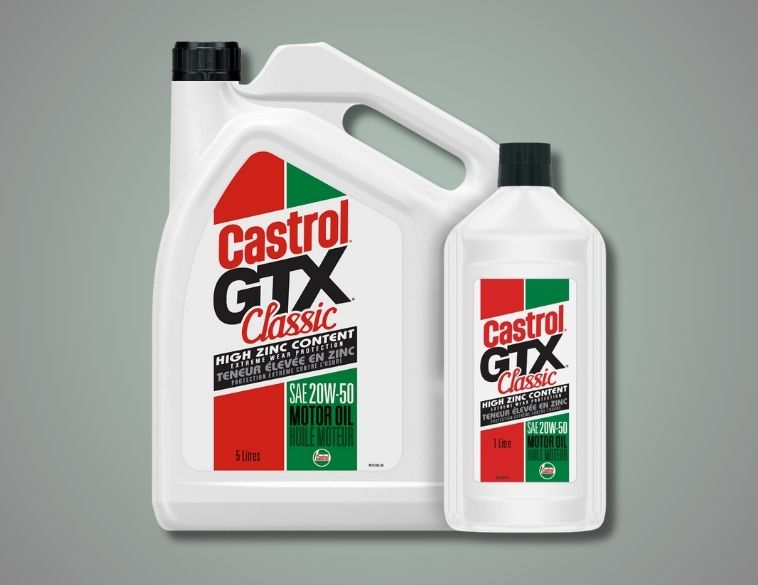New high zinc formulation is specifically designed for older vehicles with flat-tappet camshafts as well as high performance and racing applications.
As automotive engineering and technology evolved over the decades, so did lubrication requirements for engines and driveline components. This means that oils designed for modern vehicles aren’t always compatible with older cars and trucks and vice versa.
This is why lubricant manufacturers like Castrol have developed motor oils designed for specific types of vehicles. A good example is Castrol GTX Classic.
High performance formula
First introduced in the UK market and now widely available in Canada, Castrol GTX is a high-performance formula designed for classic vehicles and muscle cars, such as those with traditional cam-in-block pushrod engines, those with flat-tappet camshafts and mechanical lifters, as well as hot-rodded engines with more aggressive, high-lift cam profiles and high-tension valve springs.
In these kinds of applications, the ability to maximize protection against metal-to-metal contact becomes critical, especially in more high-performance engine configurations. And an effective way to that is by employing lubrication formulas that feature high levels of zinc and phosphorus. In the case of Castrol GTX Classic, high-zinc (ZDDP) anti-wear additives are heat activated, which means that as the engine warms up, the sliding and rolling motion of the engine’s moving parts, particularly the valvetrain components, takes place on top or within the ZDDP anti-wear film. As a result, metal to metal contact is reduced, providing optimum protection, with a thick film remaining even under severe operating conditions, such as drag racing.
Racing applications
According to Donny Braga, Brand Marketing Manager at Wakefield Canada, which manufactures and distributes Castrol products in this country, Castrol GTX Classic is not only designed for classic and high-performance cam in-block engines and flat-tappet valvetrains, but also alcohol-fueled engines, including those used in motorsport applications, such as sprint cars, some open wheeled racers and some drag racing applications, such as NHRA Top Alcohol Dragsters and Funny Cars.
“Besides the high zinc content, the high phosphorous content in Castrol GTX Classic also minimizes ‘foaming’ and provides high-temperature protection against the degradation of the oil,” explains Braga.
Another important consideration, for both workshops and classic vehicle owners, is that while Castrol GTX meets the American Petroleum Institute (API), SJ service classification, which refers to 2001 and older year model vehicles, it cannot be used in vehicles equipped with catalytic converters, or those equipped with wet clutches (where the friction material is held within an oil bath that both cools and lubricates the clutch disc). It also isn’t designed for cars and trucks equipped with roller camshaft engines.
Unlike flat-tappet engines, where the cam lobes constantly slide on top of the valve lifter, Roller engines have camshafts that roll, instead of slide on the lifters. The result is less friction, meaning high levels of zinc additives aren’t required to prevent friction and premature camshaft wear and using an oil with high zinc content can actually damage these types of engines.

20W50 grade
Besides its high zinc and phosphorous content, Castrol GTX Classic also comes exclusively as a 20W50 oil at the present time. Braga says that a primary reason, is because that many older engines, such as the overhead valve V-8s common in North American built vehicles from the 1950s, 1960s and 1970s, featured looser tolerances and far greater bottom end clearance, meaning that thicker oils provide better protection of the moving parts including the bearings, crankshaft journals, rods and wrist pins, especially as the engine warms up.
“Our research with our colleagues in both the U.S. and the U.K. determined that 20W50 was the right grade to introduce Castrol GTX Classic to the market,” explains Braga. Furthermore, he says the timing of the introduction of this product to the market could not be better.
As we enter the spring season, and more classic vehicle owners look to get their vehicles out of storage and ready for the summer driving and racing season, Castrol GTX Classic will represent a highly suitable option when it comes to lubrication, especially, as Braga notes, “around 70% of classic vehicle owners tend to change the oil in their vehicles each spring.”
Castrol GTX Classic is available directly through Wakefield Canada, as well as via local parts distributors and for more details, interested workshops and their customers can contact their Wakefield Canada representative directly.



